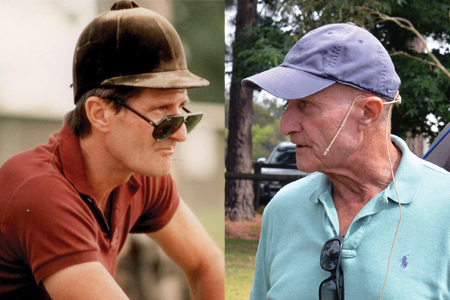 Chris Hector looks back…
Chris Hector looks back…
Photos by Roz Neave and archives
Right from the start George Morris was a controversial figure in Australia. He came to teach for the first time in 1987. At his first Olympic squad training school, he asked of one rider (who briefly flashed across the Australian scene and just as quickly disappeared) Is there one thing this boy can do right? Before deciding that whatever it was that he did, George decided it wasn’t going to be at his clinic, and banished him.
After that first clinic, Colleen Brook interviewed George for THM, it set the scene for the next 30 years….
What are the areas in which we need to work?
“The biggest problem is because the base is not educated – your riders are intuitive horsemen, but they are not always educated and polished. They get it done, and they have to get it done by force! If you don’t know how to do it through two thousand years of knowledge from Xenophon down to our time, then if you are going to get it done, you are going to get it done by force. We all use force to some degree, but the balance here is too much force and not enough knowledge, and when that knowledge becomes deeper and deeper and deeper and deeper, the force is going to become less and less and less.”
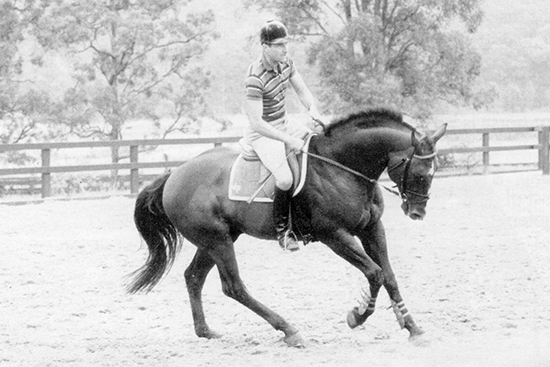 At the first clinic George rides Chris Chugg’s Sky High, and at the 2010 clinic he watches Chugg’s new star, Vivant
At the first clinic George rides Chris Chugg’s Sky High, and at the 2010 clinic he watches Chugg’s new star, Vivant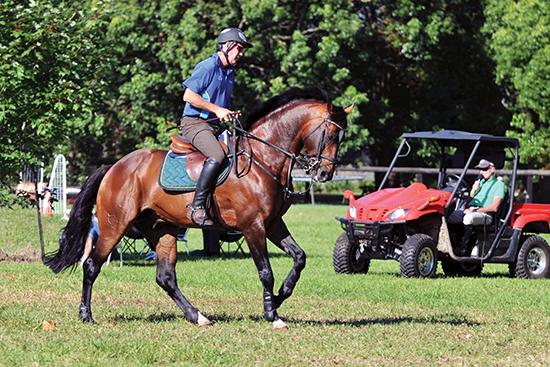
How does that affect our jumpers at the top level?
“I think horses pay for it physically, maybe not your horse, but maybe the horses that belong to people just a little down the ladder; they pay for it physically. Leg wise, back wise, brain wise, they pay. At the very least when you use force, they are going to look back at you a little more and jump a little flatter. When a horse is looking back at force that means their heads come up, they contract their jaw, they contract their backs, everything is flatter. Nothing beats a relaxed, rounded horse.”
A year later, George was back in Australia, for a second squad clinic and I was lucky enough to have my first live taste of the wit and wisdom of George H Morris.
There were some (notably unsuccessful) showjumping riders who were unimpressed when George came to Australia for the first time. He had nothing NEW to offer, no magic gimmicks to sure-fire success. And they are at least partly right, for the essence of George Morris’ horsemanship is age old…
The quote is almost thirty years old, but he might have said it yesterday;
“The methods I teach have stood the test of time, not only with me, but with many other trainers. If you try to circumvent a problem with a trick or gadget or a funny technique, the problem will always come back.”
The solution? Well it started then, as it does now, at your feet:
“My weight belongs in my heels, not in my knees, What keeps the stirrups in place is not pushing down into the irons – it’s the weight driving down into your heels. It is better to have reins that are too long rather than too short, and better to have stirrups that are too short than too long.”
And I am sure you will hear this one in 2017 when George resumes his clinic circuit:
“All people do the wrong thing with a high headed horse because it’s a natural reaction to drop your hands when the horse goes high. DONT. When the horse raises its head, follow him up a little and show the horse the way to lower his head. If you try to pull his head down, then I can come back in twenty years and his head will still be up!”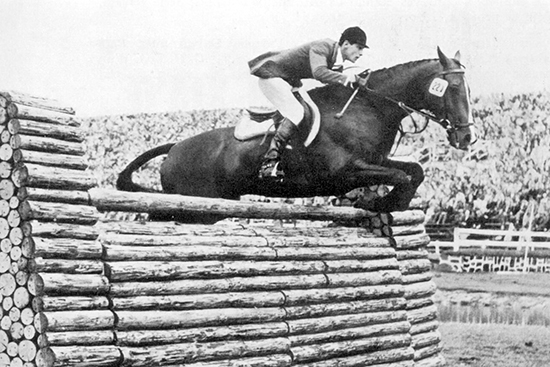
At Aachen in 1960 with Night Owl
Sadly, thirty years down the track, there are still riders trying to drag their horses heads into place, I guess they will still be trying in 2046, although George may not still be running his clinics in Vicki Roycroft’s splendid paddock then to remind them how to get a frame.
And yes, he upset many with his frank commentary:
“I’ve been trying in Australia to get rid of hollow horses. There are riders who sit too far back in the saddle and hollow the horse’s loins. Those who sit back in the saddle have to move forward.”
“I never saw a country where less respect is paid to training horses. Your horses go with their heads to the outside and their bodies to the inside. It’s not your jumping down here that is the problem – it’s your understanding of training and dressage which is so poor. Don’t give me hogwash that the horses are too hot to handle, It’s just that the training is so poor.”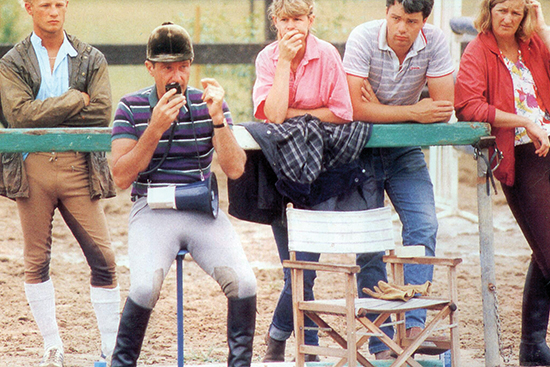
“You don’t need jumping in Australia, you need riding.”
It is a little chastening that while we now have many more stylish and effective jumping riders in our competition ranks, you can still see so many riders who would benefit by thinking about what George had to say all those years ago…
“Ride with your thumbs up! There is a funny habit in Australia, where you invert your thumbs. Your hands are not just flat, they are past flat, they are inverted. The thumbs should be up.”
And the riders had problems at the other end of their bodies:
“You don’t kick in riding. It’s wrong. Kicking de-sensitizes your horse to your legs, and every time you take your leg off the horse to kick him, you jeopardize your security. Squeeze the horse, and if he doesn’t go forward, tap him with the whip. When a horse is schooled to legs, you don’t need legs, you just think legs.”
“Before you can understand hands, you have to understand legs. You can’t do much with hands until you have legs that are independent and soft.”
“Never kick a horse, that’s for the birds. In serious training we always carry a whip, not to beat the horse but to support us.”
“I don’t kick horses. If I want more than leg, but less than a whip, then I’ll cluck to the horse. It’s a nice aid, clucking gives the horse some heart.”
“All over the world they teach riders to have a tapping, living leg. It’s a dreadful thing, a deadening thing, to be at the horse with your legs all the time.”
“The lesson of legs is through your whip – not through your legs.”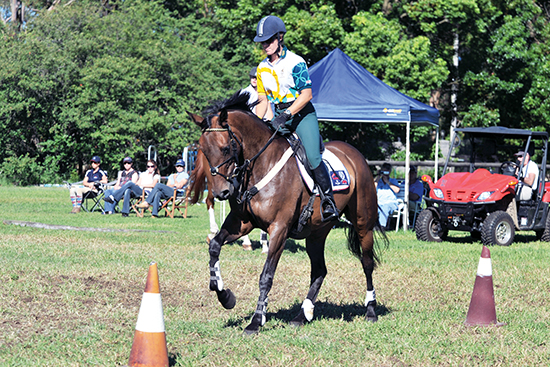
“Eighty percent of your time on the horse should be dressage and only 20 to 30% jumping. In Australia, I object to your education – not your guts, or experience or athletic ability – your education. I grossly object to hollow, hollow horses that jump upside down and hit their jumps.”
“Down here you people jump better than you ride.”
“Ask yourself – what originated style? Function! Function gave us form. If you teach good form, you get function. Why do we put the stirrup on the ball of the foot? Because it creates a softer, more effective ankle. We do it NOT to look better but to DO it better.”
If George’s teaching thirty years ago is still 110% relevant today, the same cannot be said of the refrain heard loud and clear back then – TOO MUCH DRESSAGE WILL TAKE AWAY THE JUMP. Today, there are only a few aging troglodytes who trot the cliché out, but there are still a few who don’t understand that while George always wanted his riders to ride with absolute control on the flat (that’s kind of a definition of dressage) he always wanted, and still wants, the horse to be left alone to make its own mistakes and learn its own lesson over jumps…
“You have a habit here when you are coming to a short distance of starting to hook, instead of waiting and letting your horse find his jump.”
“I like a horse being stupid and green and hitting the jump. There is nothing so nice as a horse that has learnt to help himself. The Canadian showjumper, Ian Millar rides his horses out of balance in training. He does everything wrong to make it hard for them at home – in the Show Ring, he rides like an artist. He’s the best in the world today.”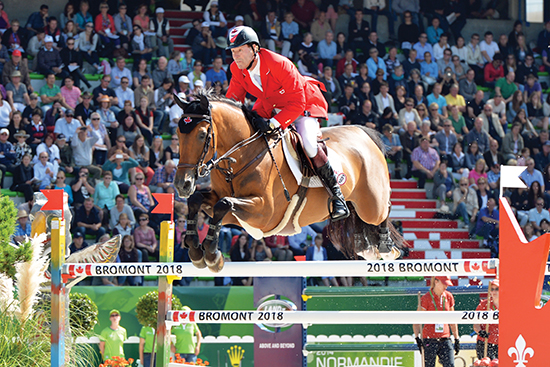
Ian Millar rides his horses out of balance in training… in the Show Ring, he rides like an artist. He’s the best in the world today.
And yes, in 2015, the Canadian was still on song, winning three Grand Prix in the year. Wonder why?
Sitting there at the VEC watching the clinic, it was the first time I realized the way in which an instructor could create jumping lines that actually taught the horse the lesson…
“Give to your horse. Let the horse study the jump, let him learn to bascule.”
And suddenly it all happens. The rider sits quiet, the horse rounds itself beautifully through the air, clears the jump neatly and cleanly – and the teacher is delighted:
“There you saw it. You did it. If you don’t like the first stride you see, sit still and bypass it, and take the short option. If you see a long option, a short one will come up. Relax your hands and arms and you will see it better.”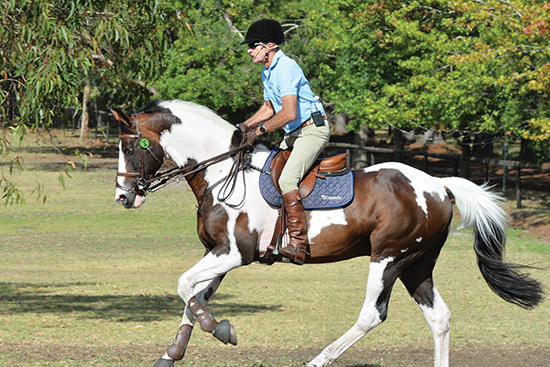
George rides Copabella Visage – “I like this Pinto”
At the end of the session, George made it clear where his priorities lie:
“I’m interested in rider’s technique because I think it makes life easier for horses. Horses suffer when they are badly ridden – and the better the rider, the nicer the horse’s life.”
The better the instruction, the nicer the writer’s task. George was kind enough to autograph my copy of his Hunt Seat Equitation, with the inscription, To Chris – a good watcher. I’ve lost count of how many hours I’ve spent in the intervening three decades, watching this genius at work, but they were always a riveting experience, it was always easy to be a good watcher.
Enjoy your year off George, good luck with your Brazilian team in Rio, but we hope to see you back in action next year.
This article first appeared in the March 2016 issue of THM.
